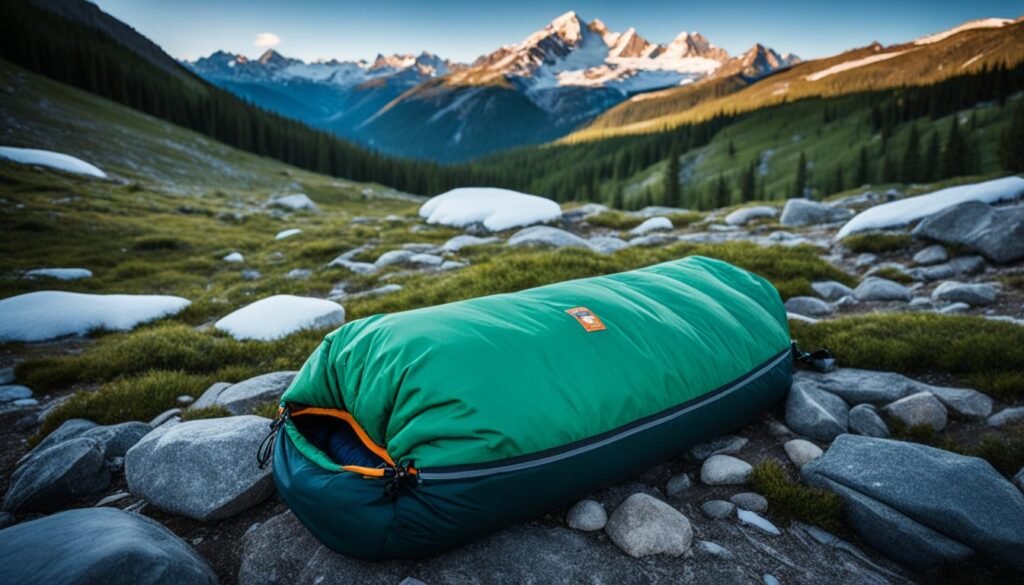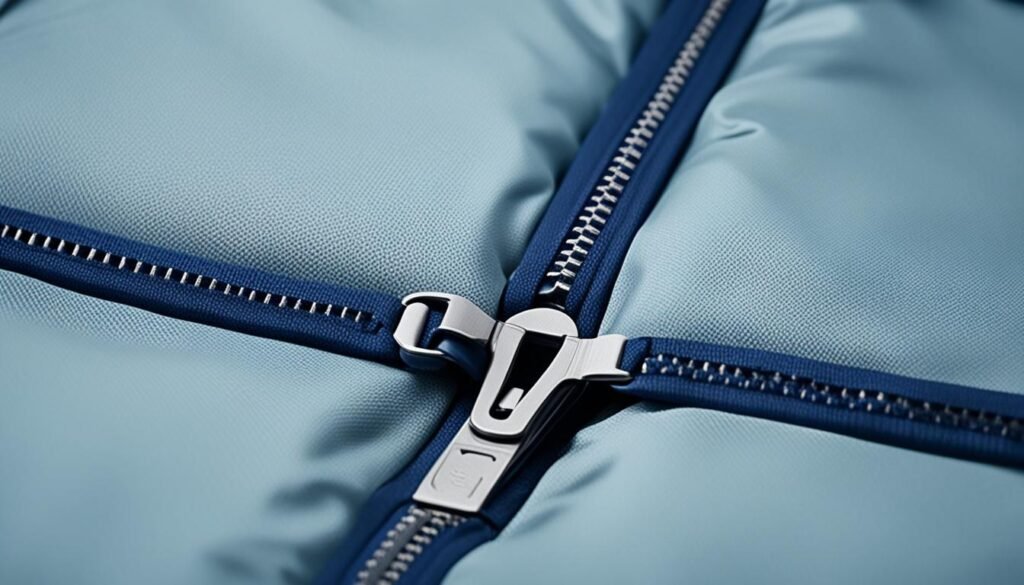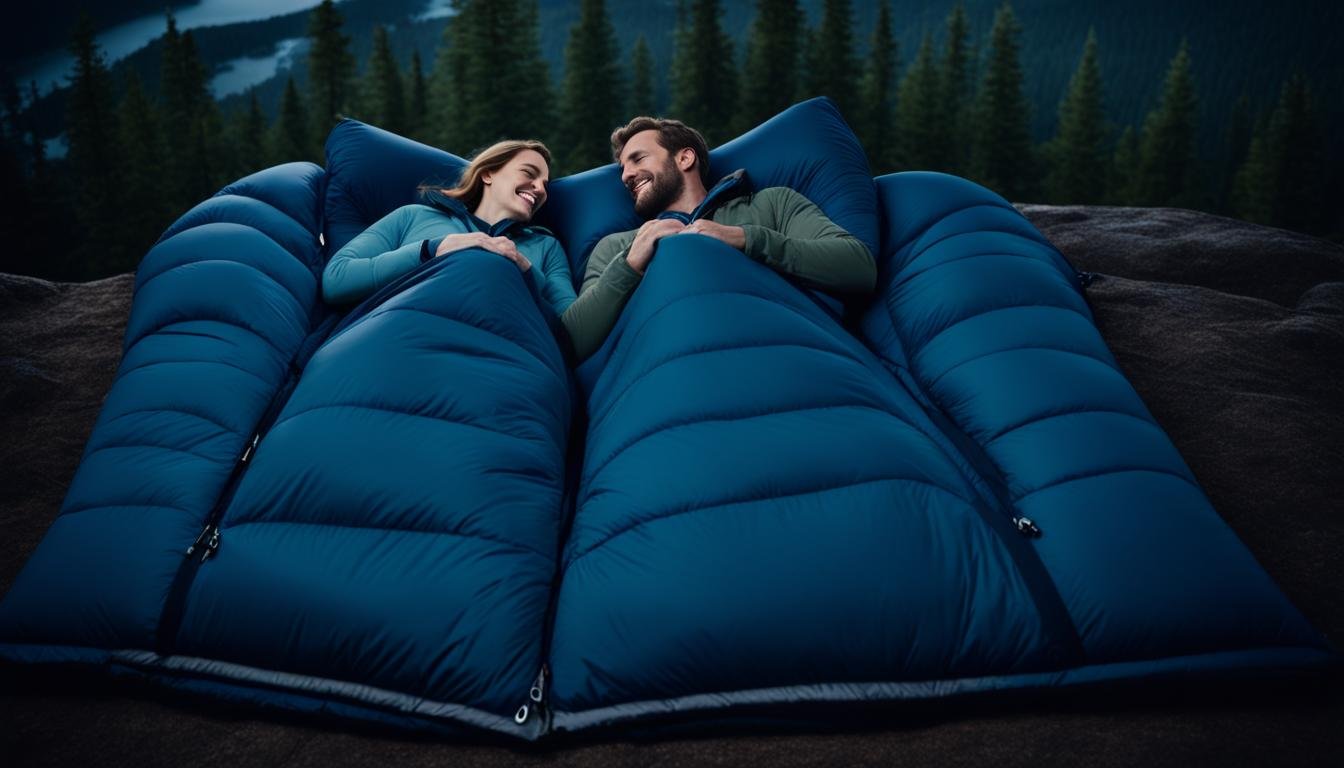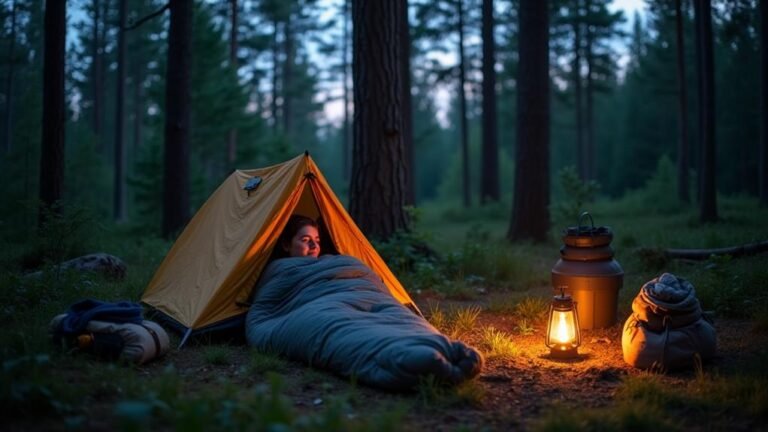Did you know that over 90% of untreated down is water-resistant in 900 Fill Power Goose Down sleeping bags?1 This fact shows how much outdoor gear has improved. It’s especially clear with zip together sleeping bags. These bags let us connect when we want, keeping us warm and cozy.
By zipping two sleeping bags together, we get a big, shared area to sleep in. We can also easily separate them if we need to.2 This feature is perfect for camping or hiking with others. It keeps us warm and close, making our adventures even better.
Key Takeaways
- Zip together sleeping bags offer a versatile and comfortable solution for outdoor enthusiasts.
- These bags allow couples or friends to share body heat and create a cozy, customizable sleeping environment.
- The zip together feature provides convenience, warmth, and a sense of togetherness during outdoor adventures.
- Zip together sleeping bags come in a range of temperature ratings, insulation types, and features to suit different needs.
- Proper sizing, fit, and zipper functionality are crucial for a comfortable and user-friendly experience.
Introducing the Zip Together Sleeping Bag
Versatility is crucial when picking outdoor equipment. Every adventure is different, so your gear must suit various activities and climates. Zip together sleeping bags are a smart choice for this reason. They let you join two bags, perfect for when you need to stay warm with a partner or friend.3 You can easily separate them too, good for solo trips or different group sizes. This flexibility is a big plus of zip together sleeping bags.
The Importance of Versatility in Outdoor Gear
Choosing outdoor equipment means considering many factors. Every trip varies in activities, weather, and who you’re with. Zip together sleeping bags adapt well to these changing needs. They let you change the sleeping setup to exactly what’s needed for that adventure.
Benefits of Zip Together Sleeping Bags
Zip together sleeping bags have great benefits. They let people combine bags, keeping you and a partner snug.3 At the same time, you can use the bags separately. This is handy when sleeping alone or with different groups.3 Their adjustability brings convenience, comfort, and the flexibility to meet any situation or preference.
Choosing the Right Temperature Rating
When you pick a zip together sleeping bag, think about the temperature rating. This rating shows the coldest weather the bag can handle.4 Bags fall into about three groups: Summer (+30° and up), 3-Season (+15° to +30°), and Winter (+15° and lower).4 Make sure you know these ratings to get a bag that keeps you warm enough.4 A bag near 32°F (0°C) is good for spring, summer, and fall outings. But for winter adventures, you might need a bag rated to 0°F (-18°C).5 It’s key to think about the weather where you’ll use the bag to choose right.
Understanding Temperature Ratings
5 Sleeping bags have comfort and limit ratings, thanks to ISO/EN tests. These help compare different brands and find a bag that’s warm for you.6 The temperature rating is the lowest outdoor temperature for comfy sleep.6 Most big sleeping bag brands follow the EN testing standard for their ratings.
Seasonal Considerations
6 Bags for three seasons range from 5-29°F, offering a lot of use.6 For extreme cold down to -40°F, there are bags for climbing or skiing. Think about the temperatures in the areas you’ll visit to pick the best bag.
Insulation Types: Down vs. Synthetic
Choosing between down and synthetic insulation for a zip together sleeping bag matters a lot. Each type has its own strengths and weaknesses. It’s important to think about what’s best for your outdoor trips.
Pros and Cons of Down Insulation
Down is great because it’s light but keeps you warm and fluffy for a long time. It uses feathers to trap air for insulation. These feathers can have different fill powers, like 550fp or 900fp.7 But down insulation doesn’t work well when it gets wet. This makes it not the best choice for rainy days. Plus, it can cost more than synthetic insulation.
Advantages of Synthetic Insulation
On the other hand, synthetic insulation, like Primaloft, still keeps you warm when it’s wet.7 It’s made from man-made fibers that don’t soak up as much water. This is perfect for adventures in damp places. Synthetic sleeping bags are also tough, handling wear and tear better than down. They might be a better fit for those with a tighter budget.5
Think about the weather, your budget, and what you like when picking a sleeping bag. Knowing the good and bad of down and synthetic helps. It ensures you choose what meets your needs and wants for the outdoors.
Weight and Packability Considerations
Choosing a zip together sleeping bag means finding the right mix. You need to consider weight, packability, and how warm it keeps you. Down-filled bags are light and warm, making them great for those who hike a lot.8 But, they might not stay warm if they get wet.5 For easier outings like car camping, a heavier bag that’s warmer might be a better fit.5
Balancing Weight and Warmth
Backpackers, in particular, need their gear to pack down small.8 Figuring out which features matter most for your trip helps. It ensures you pick a sleeping bag that’s just right.8,5
Compact Packing for Backpacking Trips
Light and squishy, down insulation wins for many backpackers. But synthetic insulation works better in the rain and costs less.5 A bag’s design and what’s stuffed inside affect its heft. Fabric technologies and high-fill downs are top choices because they keep you warmer without adding much weight.5 Even the shape, like a mummy bag that hugs your body, helps cut down on weight.5
Best Sleeping Bags with Zip Together Option
Many top outdoor brands make best sleeping bags that can zip together. They are great for all kinds of outdoor fans. The Kelty Tru Comfort Doublewide, ALPS OutdoorZ Redwood, and Coleman Brazos are some favorites. These bedrolls come with different temperature ratings and insulation types. They also have features that are just right for camping, hiking, and travel.9
You can pick from these versatile models. They are perfect for sharing body heat with a friend and for solo use too. The top choices find the right balance between warmth, weight, and packability. This ensures a good night’s sleep outdoors.9
The Macpac Express 400 XL is very light. It weighs 820g and has a lot of warmth for its size. On the other hand, the Macpac Express 600 STD is just as warm but a bit heavier at 980g. Both can be packed together easily for trips.9
These sleeping bags are lighter and just as cozy as Kat’s old one. They are long but come in different zips. If you want to join them together, having zips on both sides is best. Zipping the bags makes them warmer and feels like a big, cozy bed.9
But, be careful. Not all zippers match. The Alpine, Spark 45°F, and Spark 30°F bags can’t be zipped with others. However, the 2024 Women’s Spark 15°F and Spark 0°F can join with Sea to Summit bags on the right side.10
Their 2024 Spark Pro, Ascent, Women’s Ascent, and more, have specific zipping instructions. This makes it easier to find one that matches your Sea to Summit sleeping bag. Even older models before 2010 have detailed notes on zipping.10
Durability and Weather Resistance
When picking a zip together sleeping bag, think about how long it will last and if it can handle bad weather.2 The type of fabric used in the bag’s shell and its denier rating matter a lot. These factors show if the bag can handle being rubbed, torn, or poked. Choosing bags made of strong materials like ripstop nylon or polyester means they will last longer.2 Bags with water-resistant coatings keep you dry in the rain. They also stay warm, which is important if the bag gets wet. So, look closely at the materials and features of a sleeping bag. This way, it’ll stand up to the tough conditions of outdoor use, camping, and hiking.
Shell Materials and Denier Ratings
The outer layer and strength of the fabric, known as denier rating, are key in making a zip together sleeping bag tough. Materials like ripstop nylon or polyester last longer. They resist tearing and damage well, which is crucial for outdoor adventures. Picking a bag with a strong outer layer and the right denier rating is wise. It helps your bag last longer and gives you peace of mind on your camping and hiking trips.
Water-Resistant Coatings and Treatments
When it comes to dealing with moisture, what’s on the outside of a zip together sleeping bag is just as important as the inside. Weather resistance gets a big boost from outer and inner water-resistant treatments. These features keep the bag dry inside and keep you warm, even in the rain. It’s essential to check these features to ensure a bag works well in wet conditions. This preparation helps you stay protected from the elements during outdoor use.

Sizing and Fit
Getting the right size and fit is key for a comfy zip together sleeping bag. It’s important the bag is long enough for your height. This way, you can stretch your legs without losing warmth.11 Make sure you choose bags that zip together smoothly.
Proper Sleeping Bag Length
The perfect sleeping bag should let you stretch out comfortably. It keeps your legs warm without being too tight. Aim for a length that fits you well to avoid cold spots.
Adjusting for Body Shape and Size
It’s not just about length. Making the bag fit your shape helps a lot. Look for bags with adjustable parts like hoods and neck baffles. These features reduce cold areas and keep you cozy. Picking the right size and fit in a zip together bag makes camping more fun and relaxing.
Finding the best size, fit, and features is crucial. It ensures our sleeping bags meet all our outdoor needs. They keep us warm, comfy, and ready for adventure.
Zipper Design and Functionality
The design of a zip together sleeping bag’s zippers is key. Bags with dual zippers are versatile. You can open them completely or separately. This lets users customize how they sleep.
It’s vital that the zippers don’t snag. This can make using the bag frustrating. High-quality zippers help. They move smoothly without getting stuck.
Having pull tabs and protective flaps on the zippers makes things even smoother. They add to the bags’ ease of use. So, choosing a sleeping bag with well-designed zippers is important for an easy outdoor trip.
Dual Zippers for Versatility
Dual zippers on a sleeping bag offer unique versatility.12 They let you share warmth and create snug sleep spaces with friends or solo. This choice means you can adjust how you use the bags anytime.
Anti-Snag Zipper Features
Quality zippers are a must for zip together bags to work well.12 They should be snag-free. This means they won’t get stuck, keeping things easy and fun outdoors. That’s why features like protective parts and easy-to-grab tabs matter so much.

Additional Features to Consider
Besides zipping together, sleeping bags offer many perks for outdoor lovers. Draft collars and draft tubes by the neck and shoulders cut down on heat loss. This keeps you warm in chilly nights. Stash pockets hold small things like headlamps or earplugs close by. They help you find your items easily. Compression stuff sacks also make the bag easier to carry and store. Check if a sleeping bag has these extras to get the most out of your trip. Learn more about choosing the right features.
Draft Collars and Tubes
If a sleeping bag has draft collars and draft tubes, it can keep you warm better. These features decrease heat loss around your neck and shoulders. This helps you stay cozy in colder weather.9
Stash Pockets and Storage Sacks
Having stash pockets in your sleeping bag lets you keep essentials handy. Items like headlamps or earplugs stay within easy reach. Plus, compression stuff sacks make carrying and storing the sleeping bag simpler.9
Care and Maintenance Tips
It’s vital to care for your zip together sleeping bag to make it last longer and work better. Store it in a breathable sack or fold it loosely. This keeps the loft and warmth inside, whether it’s down or synthetic. Clean it as the label says, using gentle detergent and no fabric softeners, to prolong its life.13
Proper Storage and Cleaning
Try spot cleaning and air drying to keep your bag smelling fresh and free of dirt.13 Use a cotton or mesh bag when it’s not in use to avoid squishing the fill.13 Getting professional cleaning for down bags is a good idea to keep them in top shape.13
Extending the Lifespan of Your Sleeping Bag
Down bags need a longer time to dry after a wash, about two to three hours usually.13 For hand washing, soak, rinse, and dry carefully to protect the fill.13 Only use a front-loading or top-loading machine without a middle part for washing.13 Make sure it’s fully dry before putting it away to avoid damage.13 Stick to these tips, and your sleeping bag will be ready for more camping trips than you can count.
Conclusion
Zip together sleeping bags give outdoor lovers a great way to snooze under stars. They let us mix and match our sleeping spots and keep each other warm. Picking the perfect one means looking at its warmth range, what it’s stuffed with, how heavy and small it is, how tough and weatherproof it is. This helps us get the right fit for where and when we camp.
It’s also smart to check the way the zippers are made, how big it is, and what extra features it has.14 Good zippers stop any zipper troubles, and some bags even let you open the foot area when it’s hot. Taking good care of your sleeping bag will make it last a long time, ready for any adventure.
The2 ALPS OutdoorZ Redwood sleeping bag is a top pick, priced at $175, and it keeps you cozy down to -10°F. Another great choice is the2 Western Mountaineering MegaLite, going for $570. It’s filled with 850+ fill power down and weighs 12 ounces. Both of these options are dependable and comfortable, making outdoor trips more enjoyable and fun.
FAQ
What are the benefits of zip together sleeping bags?
Zip together sleeping bags let couples or pals stay warm together. They turn into a big, comfy bed. But, you can also use them separately.
How do I choose the right temperature rating for a zip together sleeping bag?
Choose a sleeping bag that fits the coldest temperature you’ll face. For spring and fall, look for a 32°F (0°C) rating. In winter, you might need a 0°F (-18°C) or even colder one.
What are the pros and cons of down and synthetic insulation in zip together sleeping bags?
Down is light, warm, and compressible. But it’s pricey and loses warmth when wet. Synthetic insulates even if it gets damp and costs less. Yet, it’s heavier than down.
How do I balance weight and warmth when choosing a zip together sleeping bag?
Down bags are light and warm. They’re great for hiking. For car camping, synthetic insulation’s waterproof benefits might be better, even if it weighs more.
What are some features to consider for the durability and weather resistance of a zip together sleeping bag?
Choose bags made of tough fabric. Look for those treated to prevent water from getting in. This ensures your sleeping bag performs well, even when damp.
How important is the zipper design and functionality when selecting a zip together sleeping bag?
Look for bags with zippers on both sides for more flexibility. Smooth zippers that don’t snag are key for easy use. This design is crucial for hassle-free camping.
What additional features should I consider when choosing a zip together sleeping bag?
Think about adding things like draft collars, pockets, and stuff sacks. They improve the sleeping bag’s comfort and make it easier to carry. These extras are great for outdoor lovers.
How do I properly care for and maintain my zip together sleeping bag?
Keep your bag clean and dry as the manufacturer advises. This will make sure it lasts a long time. Spot clean and air dry your bag for the best results.
Source Links
- https://zpacks.com/products/20f-full-zip-sleeping-bag
- https://www.outdoorgearlab.com/topics/camping-and-hiking/best-sleeping-bag
- https://www.adirondackexperience.com/story/2016/04/camping-part-2-sleeping-bags-pads
- https://www.rei.com/learn/expert-advice/sleeping-bag.html
- https://www.rei.com/learn/expert-advice/sleeping-bag-backpacking.html
- https://blog.kelty.com/how-to-choose-a-sleeping-bag/
- https://www.outdoorlife.com/gear/down-vs-synthetic-sleeping-bag/
- https://www.switchbacktravel.com/sleeping-bag-weight-comparison-chart
- https://www.cyclingabout.com/couples-consider-zipping-your-sleeping-bags-together/
- https://seatosummit.com/blogs/product-care/can-i-zip-two-sea-to-summit-sleeping-bags-together
- https://www.whiteblaze.net/forum/archive/index.php/t-3880.html
- https://zpacks.com/products/zip-around-sleeping-bag
- https://www.rei.com/learn/expert-advice/caring-sleeping-bag.html
- https://www.trailgroove.com/blogs/entry/189-how-to-choose-the-best-backpacking-sleeping-bag/



